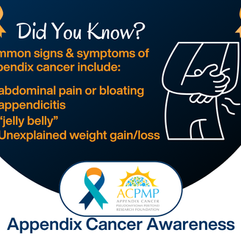Appendix Cancer Awareness Month 2025 - In Case You Missed It
- Abdominal Cancers Alliance
- Aug 28
- 3 min read
Updated: Aug 28
During August we recognized Appendix Cancer Awareness Month to bring more attention to advanced forms of this cancer. In case you missed it, here's a quick recap for the month!
Appendix cancer most commonly presents as pseudomyxoma peritonei (PMP). PMP is a clinical syndrome characterized by pools of mucin and widespread peritoneal disease. Mucin is a jelly-like substance that the body produces to protect the lining of the stomach, intestines, and the appendix. Certain types of cancer cells produce mucin that may cause organs to rupture, such as the appendix, and build up in the abdomen. PMP is classified as either a low-grade, less aggressive form, known as disseminated peritoneal adenomucinosis (DPAM) or low-grade mucinous carcinoma peritonei (LGMCP), or a more invasive form known as peritoneal mucinous carcinomatosis (PMCA) or high-grade peritoneal carcinoma peritonei (HGMCP). Overall 10-year survival for PMP is approximately 32%. However, survival is directly related to the grade of the tumor and the possibility of having a complete removal of all the tumors by an experienced surgical team.
When caught early, many types of appendix cancer are highly treatable. Cytoreductive surgery and heated intraperitoneal chemotherapy (CRS/HIPEC) is considered the standard of care treatment for all types of advanced appendix cancers. CRS refers to the aggressive surgical removal of all visible tumors. HIPEC is the infusion of heated chemotherapy throughout the abdominal cavity and is performed immediately following cytoreductive surgery.

Key Facts about Appendix Cancer
1️⃣ Appendix cancer is rare – occurring in less than 1% of all appendectomies. It is important that specialized peritoneal surface malignancy surgeons and pathologists carefully review your case.
2️⃣ According to the National Cancer Institute, appendix cancer is thought to affect just 1- 2 people per 1 million each year.
3️⃣ For all appendix cancer types, the best treatment outcomes are achieved with complete CRS and HIPEC. In other words, the complete removal of all visible disease.
Risk Factors
1️⃣ Age: The biggest risk factor is age. Age of average diagnosis is between 40-50 years
2️⃣ Lifestyle Factors such as a sedentary lifestyle, a diet high in processed foods, sugar, and saturated fats, or smoking
3️⃣ Family history
Signs & Symptoms can be similar to other conditions and are often non-specific.
1️⃣ Appendicitis: Most cases are found during appendectomy for appendicitis
2️⃣ Abdominal bloating
3️⃣ Abdominal or pelvic pain/tenderness
4️⃣ Unexplained weight gain/loss
5️⃣ Changes in bowel function
6️⃣ “Jelly Belly” - nickname for the accumulation of mucinous, jelly-like material in the abdomen
Evaluation
A physician may use some or all of these evaluation methods to diagnose appendix cancer.
1️⃣ Physical exam
2️⃣ Imaging studies: CT scan, MRI or PET/CT scan
3️⃣ Blood work to include tumor markers
4️⃣ A laparoscopic procedure may be recommended to assess the amount and location of the tumor or to determine if the tumor can be completely removed by CRS/HIPEC.
Treatment
A physician may use some or all of these methods to treat appendix cancer.
1️⃣ CRS/HIPEC: studies show a significant increase in survival, particularly for lower grade types of appendix cancer
2️⃣ Chemotherapy: can be treated with systemic chemotherapy (IV Chemotherapy) and sometimes recommended prior to surgery. Chemotherapy in combination with surgery and/or other novel approaches are considered for higher grade types of appendix cancer. Additionally, chemo is sometimes administered post-operatively.
3️⃣ Surgery: Almost all appendix cancers will be treated with surgery
Appendix cancer is a rare malignancy, occurring in less than 1% of all appendectomies. [see References: 1] It originates from a malignant, mucinous growth in the appendix, the small tubular organ connected to the colon. Because of its location, these tumors cannot always be detected with a colonoscopy. The exact function of the appendix is unknown, but more recent studies suggest that it may house certain bacteria that aid in digestion and help replenish the digestive tract after a gastrointestinal illness.[2] Appendix cancer is very diverse and includes a variety of distinct types of tumors, ranging from mixed neuroendocrine and goblet cell carcinomas to mucinous adenocarcinomas.
An appendix cancer diagnosis will also include a description of its “grade”. Grade refers to how aggressive the cancer is, which is determined based on how much cancer cells look like normal healthy cells when viewed with a microscope. A less aggressive cancer would be considered low-grade, and a more aggressive cancer would be considered high-grade.
Arm yourself—and your loved ones—with the information that matters.
Even the most proactive patients and advocates can only act on what they know. Help us spread the word about appendix cancer!
Thank You
Thanks for joining us on social media this month to learn more about appendix cancer and help spread the word!



















